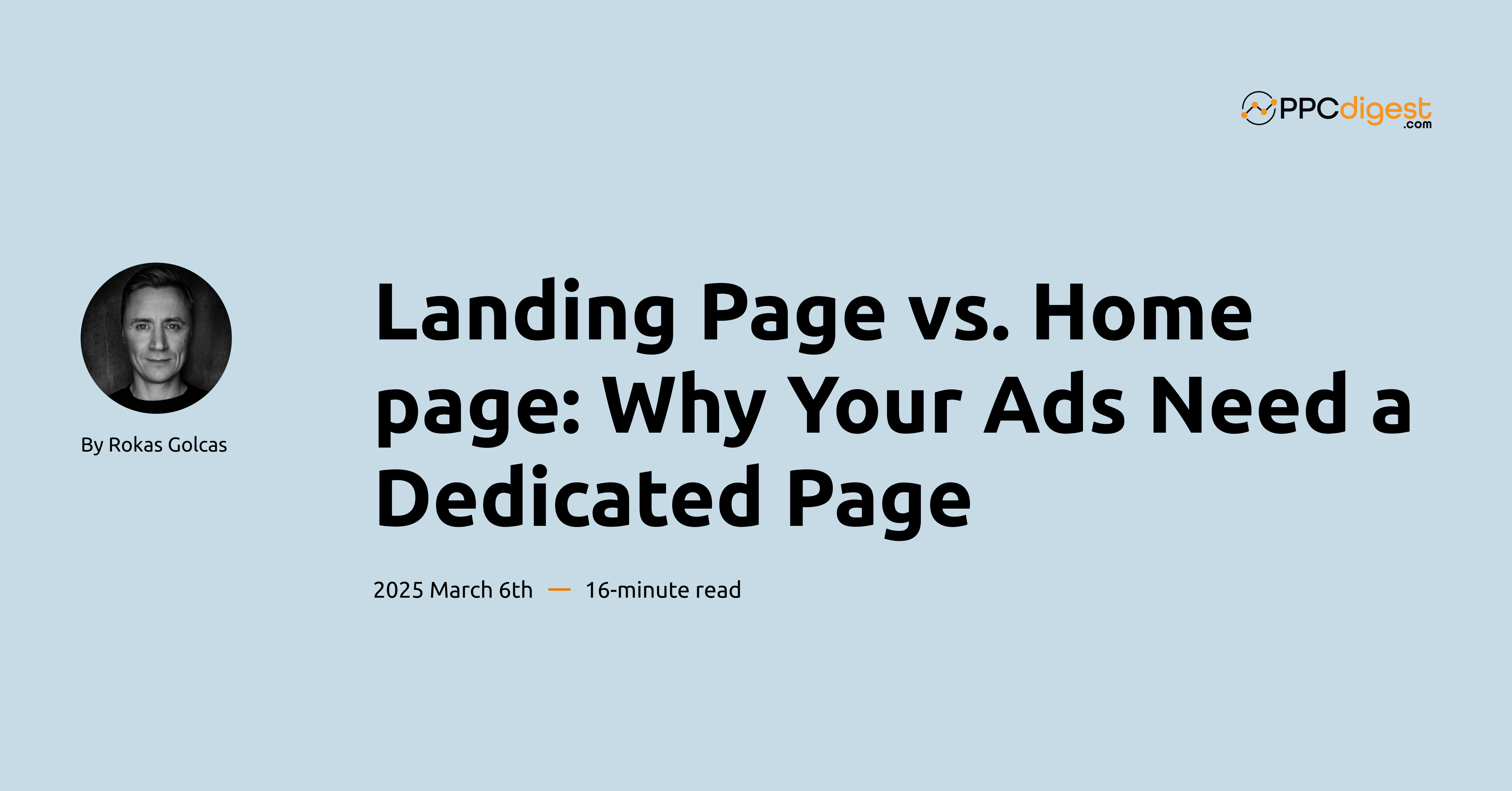
Dedicated landing pages are a game-changer in digital advertising. Unlike the home page, which covers everything about a brand, landing pages focus on one goal—conversion. This post breaks down why they’re essential, not just useful, in paid campaigns.
We’ll cover their structural, psychological, and technical advantages over the standard home page, backed by data on conversion rates, user behavior, and campaign performance.
Primary goal
Home pages function as multifunctional digital hubs designed to serve numerous organizational goals simultaneously. A typical corporate homepage might include:
- Brand history and mission statements
- Product/service catalogues
- Blog content for SEO purposes
- Customer support portals
- Investor relations materials
- Log in to user are and so on.
In contrast, dedicated landing pages operate under the Principle of Singular Focus – every element exists to guide visitors toward one specific conversion action. This concentrated approach manifests through:
- Elimination of navigational distractions: 87% of high-converting landing pages remove global navigation menus to prevent exit opportunities.
- Message match enforcement: Maintaining 100% thematic alignment between ad copy and landing page content increases conversion likelihood by 2.3x.
- Progressive disclosure design: Information architecture prioritizes conversion-driving content, with secondary details accessible through scroll or conditional reveals.
Psychological tricks to optimize landing page
The landing page allows you to use more psychological tricks to increase conversions. Something that you may not want (or nit allowed to) use on the home page.
With a dedicated landing page, you want Cognitive Load Reduction Strategies to reduce friction and minimize decision fatigue.
Hick’s Law Implementation: Limiting choices to 1-3 CTAs reduces paralysis analysis. For instance, SaaS company HubSpot found that reducing form fields from 11 to 7 increased lead capture by 37%.
For example, this is Hubspot Google Ads landing page:

Visual Hierarchy Optimization: Eye-tracking studies reveal that Z-pattern layouts with hero images, benefit statements, and contrasting CTA buttons achieve 68% faster comprehension than website-style grids.
Here’s how you can structure information on the landing page using Z-patter:

Simplify Design: Use clean layouts, minimal distractions, and clear navigation to guide users effortlessly.

Chunk Information: Break content into smaller, digestible sections to make it easier to process. You can look at the picture above as well here.
Leverage Familiarity: Use common design patterns and recognizable elements to make interactions intuitive.
Progressive Disclosure: Show only necessary information at each step to avoid overwhelming users. Look at the form above for Hubspot, they take only the information they need to provide the demo and filter out some of the audiences.
Technical Advantages of Dedicated Landing Pages
Enhanced Campaign Tracking Capabilities
We all know how important is to track your performance from any campaign, especially paid, since you’re spending money. If you use your home page as your landing page it severely limits your abilities to track performance and optimize it.
You can use UTM parameters or other parameters, but here’s what you’re missing:
Campaign version performance (A/B test variants). Usually, a home page is sort of untouchable, especially in big companies as there are too many stakeholders. So, marketing is not allowed to go too crazy with the tests.
Audience segmentation. With a dedicated landing page you can cater it to a specific audience. You can’t do it with a home page as it works as a central hub for everyone.
Deeper analytics. With a dedicated landing page, you can isolate specific audiences or channel and track:
- Conversion funnel. How the page impacts the whole funnel
- Scroll depths and heatmaps. For example, paid audience might behave differently.
- CTAs. You can test different CTAs to see what resonates better.
Page Speed Optimization
Page is important not only to platforms like Google Ads, which is a part of the landing page experience score, but also for users. Countless tests show that faster pages increase conversion rates.
Landing pages achieve 42% faster load times than home pages, because an average landing page size is 1.2MB vs 3.8MB for home pages. Most home pages are big, with images, videos, and a bunch of other content, that is usually not needed on the landing page.
Comparative Performance Metrics
Metric Website Page Landing Page Improvement
Average Conversion Rate 2.3% 5.7% 148%
Data aggregated from 1,200+ campaigns across verticals (Sources:357)
Core Components of High-Performing Pages
It takes a lot of knowledge to create a good landing page. Moreover, you have to still go through optimization process as it’s basically impossible to create a great landing page just right out of the box.
However, there are some key elements to think about.
Above the Fold Essentials:
- Headline matching ad copy. Subheadline if needed to explain further.
- Hero image/video demonstrating product-in-use
- Bullet points to reveal 3-4 benefits max.
- Primary CTA with contrasting color (accessibility compliant)
Middle Page Requirements:
- Benefit-driven bullet points (max 5)
- Trust indicators (security badges, media logos)
- Social proof carousels (testimonials, case studies)
Closing Elements:
- Secondary CTA (e.g., chat widget, phone number)
- Risk reversal reinforcement (guarantees, policies)
- Exit-intent popups capturing 18% of abandoning users. This is great for paid campaigns.
Advanced Optimization Techniques
A couple of things that I learned through experience and testing a lot of landing pages.
Technical SEO Considerations
While landing pages prioritize conversions, foundational SEO remains critical. However, you have to consult with an SEO team on how to handle multiple landing pages. You have to make sure that it is in line with SEO strategy and does not create duplicate content.
In my experience, we usually use noindex/nofollow and exclude landing pages from organic traffic. Since landing page get changed a lot, we don’t want it impacting the SEO results.
Message Match
I’ve mentioned above that your headline has to match the copy (and keywords in a Paid Search case). But you don’t stop here.
You need to go through the rest of the copy and see if that matches the general theme of the audience. In the case of Search Ads, the headline is important, but the rest of the copy has to support the headline. This will show the users that he is in the right place.
The same goes for visuals.
Mobile Optimization
I’m not talking about responsive design. I hope we’re past that. I’m talking about the mobile-first approach. With big campaigns, I create mockups for landing pages that include a separate mockup just for mobile. I have to make sure that it looks the way I want it to look. In some cases, it might look quite different from the desktop version.
Responsive design, albeit great, sometimes does not “respond” that well. For example, sometimes you have to make the CTA a lot more prominent on mobile, because responsive design reduces the size too much.
Or remove some images above the fold because they take too much space.
Dedicated landing pages are the backbone of high-performing digital ad campaigns. As consumer attention shrinks and competition rises, using tailored landing pages isn’t just a best practice—it’s essential.
Without them, brands risk weak campaign performance and losing ground in an increasingly competitive market.

Blogging gives me a chance to share my extensive experience with Google Ads. I hope you will find my posts useful. I try to write once a week, and you’re welcome to join my newsletter. Or we can connect on LinkedIn.